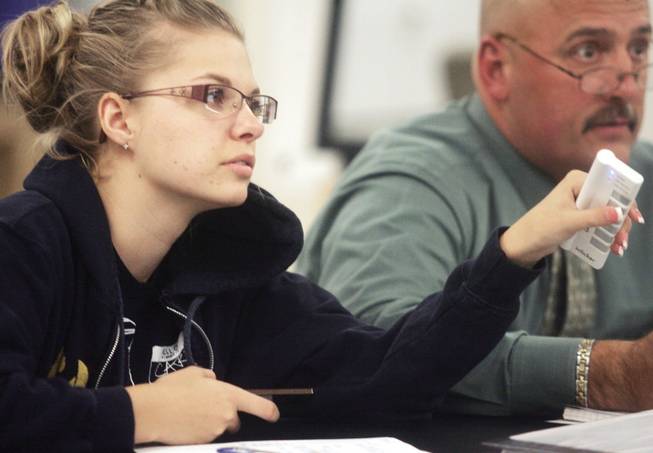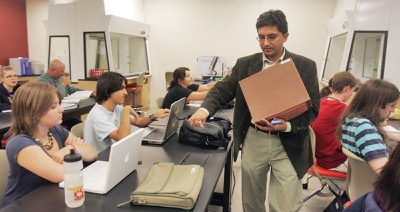
Erica Stuart uses a clicker to answer a question asked by her professor during class at Nevada State College. Part of the new technology being introduced in classrooms, the clickers allow instructors to ask students questions and receive instantaneous responses.
Thursday, Oct. 9, 2008 | midnight
Related link
To answer a question about wavelengths Sept. 24, Nevada State College science instructor Sandip Thanki did not ask students to raise their hands. He told them to press a button.
Results immediately flashed on the overhead screen. Twenty-one answered correctly, selecting "A." Two opted for "B." It was clear students were understanding the material.
For Thanki, the advent of "i-clickers" in the classroom has altered the way he teaches.
"I know exactly where the class stands by asking the questions," he said. "It improves the connection between the instructor and students."
The system is simple to work, Thanki said. A module is connected to his computer, which collects signals from students' clickers, which look like remote controls. Before class, Thanki inserts files on his computer with i-clicker questions. When students answer, results appear instantaneously on the classroom's overhead screen.
The system also allows him to make up questions on the fly.
Thanki said he knows at least five Nevada State instructors using the technology, which he first encountered as a graduate student. Students have been receptive to the i-clickers as well.
Second-year elementary education major Adilene Ellis said the clickers have helped eliminate the problem of shyness.
"It's better than raising your hand," she said. "If you're wrong, you're not embarrassed."
Second-year art major Tabetha Morgan liked the clickers as well.
"You don't have to waste time asking everyone what they think," she said.
It also encourages her to concentrate in class.
"You know there's going to be a question asked," Morgan said. "You try to pay attention a little bit more."
It was just one more example of the high-tech capabilities of the college's new Arts and Science Building, opened this year, she said.
"It's really surprising," she said. "I didn't think it would get this advanced."
Thanki said the technology provides something that was missing in the past: certainty.
"Sometimes when you're teaching students, you can see from their expressions whether they're getting it or not," he said. "But you can get nodding heads that are false."
The new system leaves him with fewer doubts. A wide distribution in answers to a question tells him to go back over material.
"I slow down at that point," Thanki said.
When most everyone gets it right, he knows he can move on, even if he had intended to allot more time.
The questions are not limited to academic concerns. Thanki will ask students in his three-hour class if they need a break. Before the clickers, two or three outspoken students could determine the outcome. Not anymore.
"You really get to hear the voice of the class clearly," he said. "The guessing's basically gone."
Dave Clark can be reached at 990-2677 or [email protected].


Join the Discussion:
Check this out for a full explanation of our conversion to the LiveFyre commenting system and instructions on how to sign up for an account.
Full comments policy